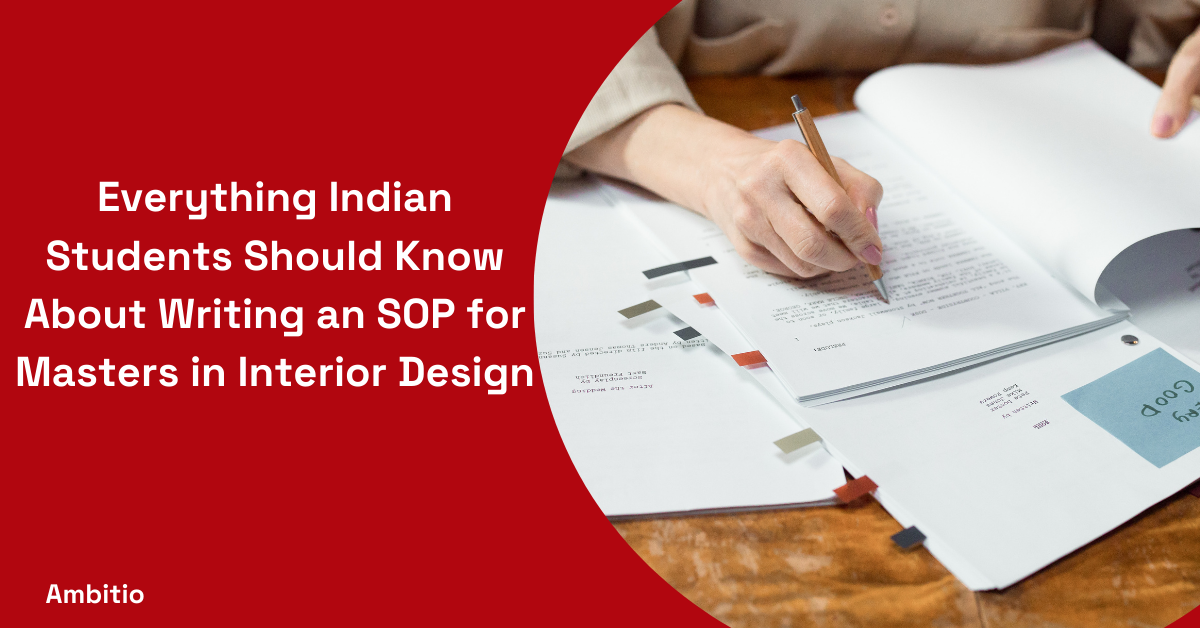19 April 2025
7 minutes read
Everything Indian Students Should Know About Writing a Statement of Purpose (SOP) for Masters in Interior Design

Key Takeaways
- Statement of purpose for masters in interior design must show real projects, spatial skills, and your fit for the program, not just passion.
- Over 85% of applicants are rejected due to vague SOPs, be specific, show design process, and back it with experience.
- Combine creative vision with technical tools like 3ds Max and Vray to impress top interior design schools globally.
Over 85% of interior design applicants get rejected not because of poor portfolios, but because of weak statements of Purpose, according to top admission officers. For Indian students, the gap isn’t talent, it’s the inability to communicate design thinking, spatial understanding, and cross-functional exposure in their SOPs.
The truth? Most statements of purpose are filled with vague passion for design, with zero mention of technical design, spatial skills, or industry exposure. A strong statement of purpose for masters in interior design, Indian students must reflect real design experience, problem-solving mindset, and your fit in the global design world, not just pretty words.
Why the Statement of Purpose Matters for Indian Students in Interior Design?
A statement of purpose for masters in interior design, Indian students is more than just a formality, it’s your design voice on paper. Admission committees at top interior design programs don’t just want portfolios; they want to understand your passion for imaginative design, your journey through interior architecture, and your real-world exposure through internships, work experience, projects, or design studios. Whether you’re applying with a bachelor of architecture or a background in art and design, your SOP must reflect how your design abilities, technical design training, and research skills make you ready for their program.

Indian students often compete with applicants trained in cutting-edge design applications, 3ds Max, Vray advanced rendering, and spatial design planning. Without showcasing your understanding of interior elements, drawing techniques, computer-aided design, and cross-functional projects, you risk falling behind. A powerful interior design personal statement bridges this gap, connecting your professional experiences, interest in interior and architectural visualizations, and your vision for the design world. It proves how you’ll contribute to the academic and creative space of any design program at university X.
What to Include in Your SOP for a Masters in Interior Design?
A strong statement of purpose for masters in interior design, Indian students must do more than express passion, it must show readiness for the field of design, backed by hands-on experience, technical abilities, and a clear career direction. With the competition including applicants trained by global studios and interior design institutes, your SOP must reflect both artistic insight and your capacity to thrive in an advanced interior architecture and design program.

If you’re aiming to become a successful designer, your SOP is your first project, and it has to be built with precision. Here’s what to include in your personal statement for interior design to truly stand out:
Your Design Journey
Explain how your interest in interior design and architecture began, whether it was inspired by interior design shows, architectural sketching, or natural curiosity. Mention if you pursued an interior designing course or a bachelor’s degree in architecture and design.
Academic Background & Certifications
Highlight your degree, training in design and architecture, advanced course in software like 3ds Max or Vray, or professional certification. Discuss how this education shaped your design expertise and visual vocabulary.
Hands-On Experience
Share relevant professional experiences, internships or work as an assistant designer at BG Design Studio, involvement in design projects, or planning and product design work. Detail how you visualized and sketched design plans and worked on texture models, productive plotting, or drawing techniques and interior elements.
Design Philosophy & Creative Vision
Reflect your passion for interior spaces, your evolving understanding of design concepts, and how you approach spatial design. Mention influences like John Wardle Architects or interior and architectural visualizations that have shaped your aesthetic.
Skills That Matter
Talk about your design skills, whether it’s architectural sketching, computer-aided design, or produce realistic 3D models. Emphasize your ability to work across teams, understand briefs, and stay current with design trends in the design industry.
Why This University
Show why you’re attending the interior design program at a specific university, mention the design program at university X, your alignment with their curriculum, labs, or faculty. Show that you’re ready to contribute to the academic community.
Future Goals
Outline how this master’s degree in architecture or interior architecture and design will elevate your career path. Whether your goal is to lead design studios or launch sustainable spaces, connect it to your long-term impact in the world of design.
How Indian Students Can Highlight Creativity and Technical Skills?
To stand out in a competitive admissions pool, Indian students must use their statement of purpose for masters in interior design not just to show passion, but to demonstrate how they think, create, and solve design problems. Top universities look beyond academic records, they seek an interior designer who blends imagination with execution.
And that means proving both creative instincts and technical fluency through your story. Here’s how to highlight both in your SOP effectively:
- Bridge Creativity with Real Work
Go beyond buzzwords. Reference actual projects where you applied your design thinking, whether it was under a project advisor, during internships, or while building prototypes. Show your design process, from concept to execution, and how it reflects your knowledge of interior space and function. - Use Specific Examples with Metrics
Refer to real experiences from your interior design personal statement examples, especially those that involved software tools, materials, or spatial planning. Mention how you balanced aesthetic goals with technical constraints like lighting, structural limitations, or user needs. - Mention Influential Projects or Studios
If you’ve worked on a cross-functional project or drawn inspiration from studios involved in architecture and interior design, name them. Describe your takeaways, maybe a hands-on workshop that helped you understand proportion or an assignment under a project advisor that involved pursue the interior elements of a public space. - Showcase Your Visual and Conceptual Growth
Your personal statement for interior architecture or architecture and design personal statement should reflect how you evolved, from sketching basic interiors to understanding human-centered environments. Include your transition from raw creativity to refined, professional thinking. - Connect Technical Skills to Creative Goals
Highlight how your design degree or training helped you transform abstract concepts into visual solutions. Talk about your mastery of rendering, modeling, and drafting, crucial to succeed in any interior design program at university. - Express Thought Leadership
Finally, position your SOP as more than just a personal statement for your interior career, treat it like a vision statement. Where do you see design heading? How do you plan to contribute? That’s what makes the best interior design personal statement, one that fuses individual flair with a vision for the future of design.
Mistakes to Avoid in Your Interior Design SOP
Writing a compelling statement of purpose for masters in interior design, Indian students often make mistakes that cost them admission, even with a strong portfolio. The issue isn’t just what’s missing, but what’s included without purpose.
Your SOP must be more than a biography; it should be a clear, targeted pitch that reflects your readiness for advanced study in interior architecture and design personal fields. Here are key mistakes to avoid:
Being Too Generic or Emotional
Many SOPs sound like personal diaries. Avoid vague phrases like “I always loved spaces” without backing them with real examples. A design personal statement needs to show not just passion, but purpose.
Missing Structure or Clarity
A disorganized SOP is a red flag. Follow a clear narrative structure as advised in any interior design personal statement- a comprehensive guide, linking your academic background, creative evolution, and goals.
Overlooking Technical Depth
Students often focus only on creativity, ignoring their technical training, tools, or project experience. Your architecture and interior design personal journey should reflect both artistic flair and discipline.
Copying From Templates
Admission committees easily detect copied content or overly inspired interior design personal statement–style templates. Be original when you write your personal statement, your story and your goals must sound authentic and aligned with the university.
Ignoring University Fit
A common mistake is not customizing your statement for your interior design application to the program. Show why you’re a fit, mention the curriculum, teaching approach, or studio culture that excites you.
10 Top Universities to Study Masters in Interior Design
Did you know? A Master’s in Interior Design opens doors to a global industry worth over USD 120 billion, with top firms seeking professionals skilled in spatial planning, sustainability, and design strategy.
For Indian students, pairing a strong architecture personal statement with a compelling statement of purpose for masters in interior design can unlock opportunities at world-leading universities. Here’s a quick comparison of 10 top universities offering a Master’s in Interior Design:
| University Name | Avg. Tuition Fees (per year) | Avg. Starting Salary | Exams Required |
|---|---|---|---|
| Royal College of Art, UK | £29,400 | £35,000 – £45,000 | IELTS, Portfolio |
| Pratt Institute, USA | $57,000 | $50,000 – $60,000 | GRE (optional), TOEFL, Portfolio |
| Savannah College of Art and Design (SCAD), USA | $39,000 | $48,000 – $55,000 | TOEFL/IELTS, Portfolio |
| Politecnico di Milano, Italy | €3,900 – €4,000 | €30,000 – €40,000 | IELTS, Portfolio |
| Rhode Island School of Design (RISD), USA | $56,000 | $55,000 – $65,000 | TOEFL/IELTS, Portfolio |
| University of the Arts London (UAL), UK | £26,000 | £32,000 – £42,000 | IELTS, Portfolio |
| Parsons School of Design, USA | $53,000 | $52,000 – $60,000 | GRE (optional), TOEFL, Portfolio |
| Delft University of Technology, Netherlands | €18,750 | €38,000 – €45,000 | IELTS, Portfolio |
| RMIT University, Australia | AUD 36,480 | AUD 55,000 – AUD 65,000 | IELTS/TOEFL, Portfolio |
| Hong Kong Polytechnic University | HKD 150,000 | HKD 250,000+ | IELTS/TOEFL, Portfolio |
Conclusion
A well-crafted statement of purpose for masters in interior design, Indian students can be the turning point between rejection and admission. It’s your chance to showcase not just your passion, but your vision, technical expertise, and readiness to contribute to the design world. Avoid clichés, be authentic, and align your story with the university’s values.
Need help creating a standout SOP that gets noticed? At Ambitio, we’ve helped thousands of Indian students craft high-impact SOPs tailored to top design schools globally. Book a free profile review with our experts and take the first step toward your dream university.
FAQs
What is the purpose of an SOP?
To explain your motivation, background, and goals for pursuing a master’s in Interior Design.
What should I include in my SOP?
Your passion, academic and professional experiences, career goals, and reasons for choosing the program.
How long should the SOP be?
Usually 500 to 1,000 words or as per university guidelines.
Should I mention specific projects?
Yes, highlight key projects or internships that showcase your skills and commitment.
How do I start my SOP effectively?
Begin with a personal experience or insight that sparked your interest in interior design.
Is it important to discuss future career goals?
Yes, clearly state your goals and how the program supports them.
What tone should I use in my SOP?
Use a professional, sincere, and specific tone without clichés or jargon.

You can study at top universities worldwide!
Get expert tips and tricks to get into top universities with a free expert session.
Book Your Free 30-Minute Session Now! Book a call now




























